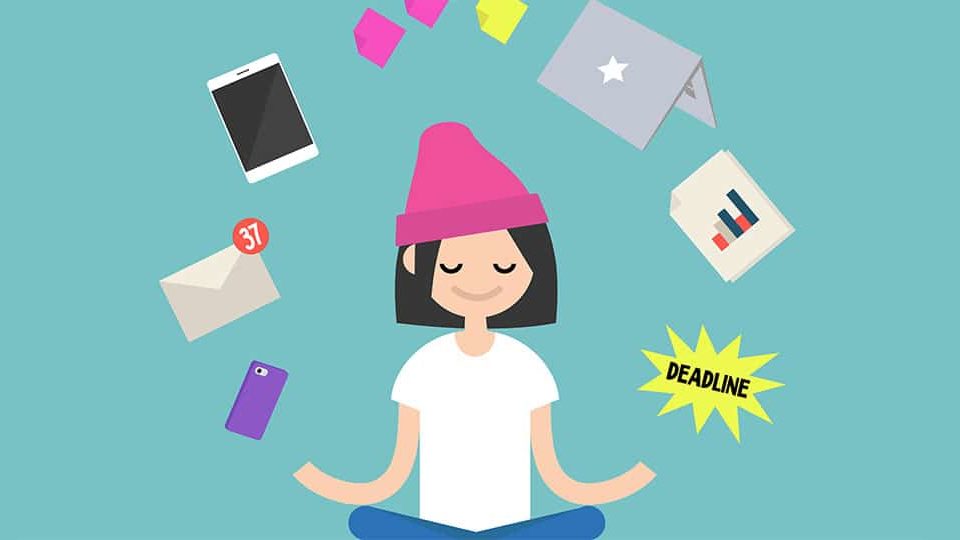Before you read, try this:
Breathe in a long, deep breath, filling your lungs as much as you can.
Then, slowly exhale through your nose.
Pay attention to the sensation of the air flowing up into your nostrils —
the coolness of the air, your chest expanding,
The slow release of the air as you release your breath,
The warmth of the air as it flows outward.
If you did that, congratulations; you just meditated.
In most modern venues, such as school or the workplace, the terms “mindfulness”, “meditation”, and “wellness” have become buzzwords that few people seem to grasp. Many associate meditation with the image of a perfectly calm, enlightened individual seated in a cross-legged pose, in a perfectly clean room, or on a serene mountain top. Essentially, for the average person, the imagery associated with “meditation” makes it seemingly unrelatable and unattainable.
Nevertheless, the practice of meditation and mindfulness is extremely accessible and has many desirable effects.
The practice of meditation is to “get out of [your] head, where the worrisome thoughts are…and drop into [your] body”. To achieve this, some common practices are to focus on the sensation of breathing or simply to close your eyes and try to focus on each part of the body starting from your toes and working your way up to your head. By doing this, a person may release any tension being held in their body, such as untensing muscles in the legs, arms, face, etc. one-by-one until they feel completely relaxed.
A common misunderstanding is that meditation and mindfulness requires a person to “turn off” their thoughts. Cleveland Clinic explains: “It’s like when you’re riding a bike past all kinds of things. You don’t stop and look at everything that goes by. Some thoughts will catch your attention while you’re meditating and others won’t. When something does, acknowledge it, and then redirect the focus back to your breathing.”
“It’s like when you’re riding a bike past all kinds of things. You don’t stop and look at everything that goes by. Some thoughts will catch your attention while you’re meditating and others won’t. When something does, acknowledge it, and then redirect the focus back to your breathing.”
Another misunderstanding is that a person needs to be in a dark, quiet, or peaceful room with no distractions in order to meditate. Although this may help a person with meditation, these conditions are not always necessary. In fact, a person could meditate while commuting to work, in a classroom, before they go to sleep, or even while they eat lunch.
Now we’ve established that you can meditate just about anywhere, anytime, in any manner that you please; but why should you meditate?
For many people—teenagers in particular—meditation has many mental and physical benefits.
For one, it decreases stress. According to Jane Ehrman, MEd, the amygdala part of the brain does not have a strong connection to the frontal lobe during one’s teenage years, which means students are more prone to erratic behaviors and emotional triggers. By meditating a few times weekly, the brain will begin rewiring to be less responsive and will allow the person to be less reactive in stressful situations.
Other benefits of meditation include improved concentration, emotional well-being, and better sleep.
Mr. Doorn, Student Assistance Counselor at Rutherford High School, explains that improving sleep through meditation is critical for students who feel stress, anxiety, and emotional distress: “Sleep is the body’s emotional immune system. Your body heals its wounds with its immune system, but restorative sleep heals and resets the mind.”
“Sleep is the body’s emotional immune system. Your body heals its wounds with its immune system, but restorative sleep heals and resets the mind.”
He leads the school’s Meditation Monday program, where students may participate in a group guided meditation in the school’s new meditation room. Although the school offers to remove demerits for students who participate in meditation, Mr. Doorn says most students go to the weekly session primarily to relieve stress and anxiety.
The high school also hosts a weekly Yoga Wednesday class; with its focus on breathing and attention to the sensations in the body, a person can enjoy a lot of the same benefits as meditation through this practice.
If you can’t make a meditation or yoga class at school, or simply want to supplement the time you spend in these programs with an at-home practice, there are countless apps, such as “Calm,” “Buddhify,” and “Simple Habit”, to meet the needs of those who want to enjoy the benefits of meditation. These apps combine nature sounds and curated guided meditations for beginners and advanced meditators alike. To see which app best suits your needs, check out this list of the Best Meditation Apps of 2019.
Whether you are feeling stressed and overwhelmed, or want to avoid feeling that way in the future, adopting a meditation practice could potentially be the answer you’ve been looking for.

